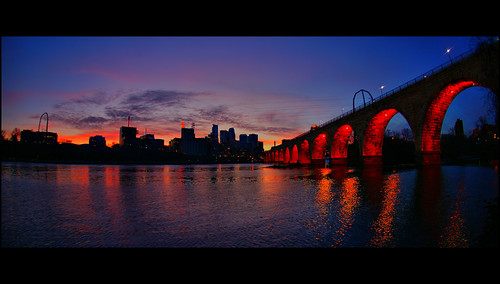
Since I got to Minneapolis almost a month ago, I have spent hours walking the city, trying to figure out how the city "works." Nothing more, nothing less.
I know a few neighborhoods -- Longfellow, Cedar-Riverside, Milltown, Northeast -- and know there are many, many more. I find a pool and learn the best times to swim and the quickest routes to get there and back, factoring in traffic and time of day. I discover where to shop, bank, dry-clean, and get coffee. I memorize the grid of "avenues" running north-south and "streets" running east-west -- at least mostly.
What has puzzled me, though, is Uptown, Midtown, and Downtown, because Uptown doesn't seem "up" at all, but "down," specifically, south of the downtown area. I was stumped.
Then, a conversation with DeAne Lagerquist, Americanist and lover of the Twin Cities, made everything clear: "It's all about the River," she said matter-of-factly. "Everything is oriented around the River."
The River -- the great Mississippi, which bends through the Twin Cities on its way to the Gulf of Mexico. Suddenly everything falls into place.
The Twin Cities developed along the River, and Minneapolis was the mill town, with the mill races and wheels. Pillsbury and Gold Medal lined the River; their signs are still here, though the granaries have long been converted to museums and lofts. Downtown was the area around the River; Midtown, a bit further afield; and Uptown, an ex-urbia, far enough away to be residential, but still close enough in to get to work.
With the River to orient me, everything suddenly made sense. It really is all about the River.
So I begin paying attention to the River: the Great Blue Heron that fishes its shallows, the loon's cry in earliest morning, the locks and how they work, the short blast of a horn that signals it's safe for boats to motor out again, where the river has structure and shoals, and the fish that hide there.
Attending to the River, I notice other things. It captures light in the evenings, lighting up the city long after the sun has set. Power lines arc along its banks, and their towers are not horizontal, but curved. This seemed to me an odd design until I realized the curves allow ice and snow to slide off, where horizontal structures would eventually only break under the weight. The arches of these powerlines are painted whiter than the vertical columns that support them. Against a gunmetal blue sky, they are luminous, like giant seabirds winging their way to the Pacific.
Attending to the River, I'm settling in. I could dwell here.
Dwelling demands a different kind of attention than pilgrimage. Pilgrimage is about destination. Even though the way becomes as compelling as the arrival, pilgrimage requires a kind of focus. I wanted to get to our destination each day; I wanted to reach the top of that hill before stopping. I wanted to log at least two hours of walking before we found a cafe con leche.
Dwelling demands I take a broader view, a more unfocused kind of focus. I pay attention, but I try to take it all in -- even what I'm not expecting to see or hear, smell or taste. Now that I've found my bearings -- or my bearing, the River --I scan broadly, taking in as many things as I can in a glance.
It's like looking for dolphins. I love to watch for them when I'm back in Delaware. There, it's all about -- the grey Atlantic. Occasionally, a fin breaks the surface, and all I know is that the next sighting will be anywhere but where I saw the first.
I learn to look with a broad view, taking in as much surface water as possible, waiting for the next epiphany. Good practice for dwelling in a place.
I'm surprised at what I'm seeing. Mary Oliver was right:
"Everything in the world
comes.
At least, closer.
And, cordially."
("Where Does the Temple Begin? Where Does It End?")
Beautiful post.
ReplyDeleteHey Marty,
ReplyDeleteLooks like I failed in my earlier effort to comment on the river. You give me more insight than I had, but what you wrote does recall the importance of rivers in the pre-railroad, pre-automobile era, which was most of human history. When waterways were a primary mode of transport (and commerce) the rivers were what both knit regions together and, oddly, what provided the boundaries between communities. Without those lovely bridges you run every morning, NE would not be part of your neighborhood. The whole of India and Hinduism take their name from the Indus River: the people who live around it and their religion. No wonder that John's vision of paradise includes the River of Life!
DeAne